四六级常见阅读题型分析Reading comprehension
- 格式:ppt
- 大小:1.52 MB
- 文档页数:12

一、大学英语四级考试简介2016年6月起实施的大学英语四级考试新题型依然由四个部分构成:写作;听力理解;阅读理解;翻译。
二、大学英语四级考试阅读理解部分考核的内容、题型及答题方式阅读理解(ReadingComprehension)部分包括词汇理解、长篇阅读和仔细阅读,测试学生通过阅读获取书面信息的能力;所占分值比例为35%,其中词汇理解部分5%,长篇阅读部分10%,仔细阅读部分20%。
考试时间40分钟。
词汇理解部分采用的题型为选词填空题。
要求考生阅读一篇删去若干词汇的短文,其长度为200~250词,然后从所给的选项中选择正确的词汇填空,使短文复原。
本部分测试考生对篇章语境中的词汇理解和运用能力。
长篇阅读部分采用一篇较长篇幅的文章,总长度约为1000词。
要求考生运用略读和查读的技能从篇章中获取信息。
略读考核学生通过快速阅读获取文章主旨大意或中心思想的能力,阅读速度约每分钟100词。
查读考核学生利用各种提示,如数字、大写单词、段首或句首词等,快速查找特定信息的能力。
长篇阅读理解部分采用的题型为匹配题。
篇章后附有10个句子,每句一题。
每句所含的信息出自篇章的某一段落,要求考生找出与每句所含信息相匹配的段落。
有的段落可能对应两题,有的段落可能不对应任何一题。
在筛选信息的过程中,要求考生在把握文章整体的基础上,对文章的细节进行整理、归纳及同义转换。
仔细阅读部分为多项选择题的短文理解测试。
要求考生阅读两篇短文,每篇长度为300~350词。
多项选择题型的短文后有若干问题,考生根据对文章的理解,从每题的4个选项中选择最佳答案。
测试考生在不同层面上的阅读理解能力,包括理解主旨大意和重要细节、综合分析、推测判断以及根据上下文推测词义等。
二、大学英语四级考试阅读理解部分考核的语言技能及要求阅读理解部分考核学生通过阅读获取书面信息的能力,包括理解主旨大意、重要事实和细节、隐含意义、判断作者的观点和态度等。
阅读部分考核的技能是:A辨别和理解中心思想和重要细节·理解明确表达的概念或细节·理解隐含表达的概念或细节(如总结、判断、推论等);通过判断句子的交际功能(如请求、拒绝、命令等)来理解文章意思·理解文章的中心思想(如找出能概括全文的要点等)·理解作者的观点和态度B运用语言技能理解文章·理解词语(如根据上下文猜测词和短语的意思)·理解句间关系(如原因、结果、目的、比较等)·理解篇章(如运用词汇及语法承接手段来理解篇章各部分之间的关系)C运用专门的阅读技能·略读文章,获取文章大意·查读文章,获取特定信息大学英语四级考试阅读理解部分要求考生达到《教学要求》中的一般要求,即“能基本读懂一般性题材的英文文章,阅读速度达到每分钟70词。

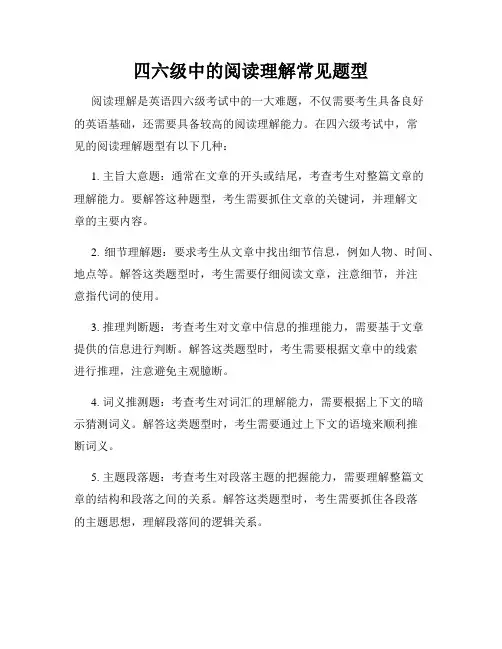
四六级中的阅读理解常见题型阅读理解是英语四六级考试中的一大难题,不仅需要考生具备良好的英语基础,还需要具备较高的阅读理解能力。
在四六级考试中,常见的阅读理解题型有以下几种:1. 主旨大意题:通常在文章的开头或结尾,考查考生对整篇文章的理解能力。
要解答这种题型,考生需要抓住文章的关键词,并理解文章的主要内容。
2. 细节理解题:要求考生从文章中找出细节信息,例如人物、时间、地点等。
解答这类题型时,考生需要仔细阅读文章,注意细节,并注意指代词的使用。
3. 推理判断题:考查考生对文章中信息的推理能力,需要基于文章提供的信息进行判断。
解答这类题型时,考生需要根据文章中的线索进行推理,注意避免主观臆断。
4. 词义推测题:考查考生对词汇的理解能力,需要根据上下文的暗示猜测词义。
解答这类题型时,考生需要通过上下文的语境来顺利推断词义。
5. 主题段落题:考查考生对段落主题的把握能力,需要理解整篇文章的结构和段落之间的关系。
解答这类题型时,考生需要抓住各段落的主题思想,理解段落间的逻辑关系。
6. 作者观点态度题:考查考生对作者观点和态度的理解能力,需要从文章中找出作者的观点和主观态度。
解答这类题型时,考生需要留意文章中的词语和修辞手法,推测作者的观点和态度。
7. 例证推理题:考查考生对例子和推理的理解能力,需要从例子中推断出某种结论。
解答这类题型时,考生需要根据文章提供的例子进行推理,注意证据的合理性。
以上是四六级中常见的阅读理解题型,掌握这些题型的解题技巧,有助于提高阅读理解的得分。
在备考过程中,考生应多进行练习,培养自己的阅读理解能力。
相信通过努力和实践,每个考生都可以在四六级阅读理解中取得优异的成绩!。
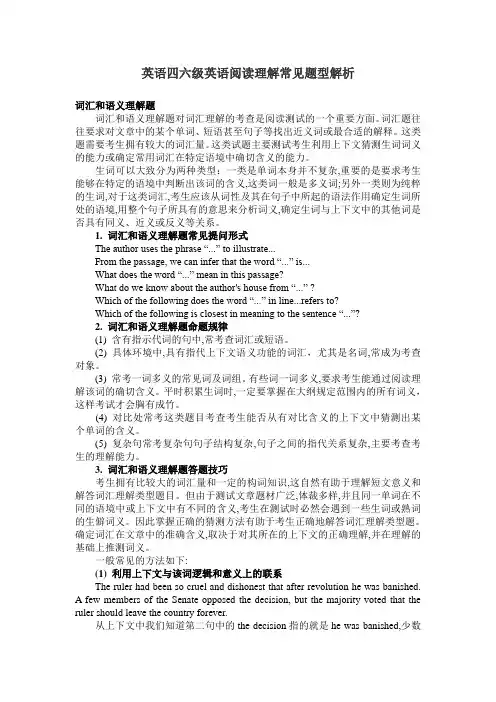
英语四六级英语阅读理解常见题型解析词汇和语义理解题词汇和语义理解题对词汇理解的考查是阅读测试的一个重要方面。
词汇题往往要求对文章中的某个单词、短语甚至句子等找出近义词或最合适的解释。
这类题需要考生拥有较大的词汇量。
这类试题主要测试考生利用上下文猜测生词词义的能力或确定常用词汇在特定语境中确切含义的能力。
生词可以大致分为两种类型:一类是单词本身并不复杂,重要的是要求考生能够在特定的语境中判断出该词的含义,这类词一般是多义词;另外一类则为纯粹的生词,对于这类词汇,考生应该从词性及其在句子中所起的语法作用确定生词所处的语境,用整个句子所具有的意思来分析词义,确定生词与上下文中的其他词是否具有同义、近义或反义等关系。
1. 词汇和语义理解题常见提问形式The author uses the phrase “...” to illustrate...From the passage, we can infer that the word “...” is...What does the word “...” mean in this passage?What do we kn ow about the author's house from “...” ?Which of the following does the word “...” in line...refers to?Which of the following is closest in meaning to the sentence “...”?2. 词汇和语义理解题命题规律(1) 含有指示代词的句中,常考查词汇或短语。
(2) 具体环境中,具有指代上下文语义功能的词汇,尤其是名词,常成为考查对象。
(3) 常考一词多义的常见词及词组。
有些词一词多义,要求考生能通过阅读理解该词的确切含义。
平时积累生词时,一定要掌握在大纲规定范围内的所有词义,这样考试才会胸有成竹。
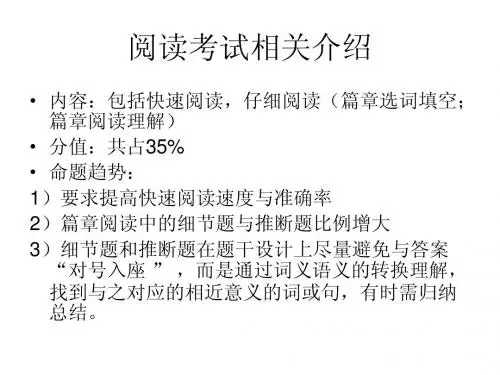

英语四六级阅读题型English CET-4 and CET-6 Reading Test Types。
Introduction:The English CET-4 and CET-6 exams are widely recognized as important language proficiency tests for Chinese students. The reading section of these exams plays a crucial role in evaluating students' reading comprehension abilities. In this article, we will explore the different types of reading questions commonly found in the English CET-4 and CET-6 exams.1. Multiple Choice Questions:Multiple choice questions are a staple in the reading sections of both CET-4 and CET-6 exams. These questions require test-takers to choose the best answer from a list of options. The options are designed to confuse students, making it essential for them to carefully analyze the passage and eliminate incorrect choices. These questions assess a student's ability to understand the main idea, infer information, and identify specific details.2. True/False Questions:True/false questions are another common type of question in the CET-4 and CET-6 reading sections. Test-takers are required to determine whether a statement is true or false based on the information provided in the passage. These questions assess a student's ability to comprehend factual information and identify details accurately. It is crucial for students to pay attention to the nuances of the passage to avoid falling into the trap of false statements.3. Matching Questions:Matching questions are often used to test a student's ability to identify relationships between information in the passage. Test-takers are presented with two lists and are required to match items from one list to items in the other list. These questions assess astudent's ability to understand the organization of the passage, such as cause and effect, chronological order, or problem and solution. They also test a student's ability to identify synonyms or related terms.4. Sentence Completion Questions:Sentence completion questions require test-takers to fill in the blanks with the most appropriate word or phrase. These questions assess a student's vocabulary knowledge and understanding of context. Students need to carefully analyze the sentence and the surrounding context to choose the correct answer. Additionally, these questions evaluate a student's ability to understand the logical flow of the passage.5. Short Answer Questions:Short answer questions require test-takers to provide brief responses based on the information in the passage. These questions assess a student's ability to understand the main idea, infer information, and provide concise and accurate answers. It is important for students to pay attention to the specific requirements of the question and provide relevant information without going beyond the scope of the passage.Conclusion:The English CET-4 and CET-6 exams feature various types of reading questions to evaluate students' reading comprehension abilities. Multiple choice, true/false, matching, sentence completion, and short answer questions are commonly used to assess different aspects of a student's reading skills. To excel in these exams, students should practice extensively, improve their vocabulary, enhance their reading speed, and develop effective strategies for each question type. With proper preparation and practice, students can confidently approach the reading section of the CET-4 and CET-6 exams and achieve successful results.。
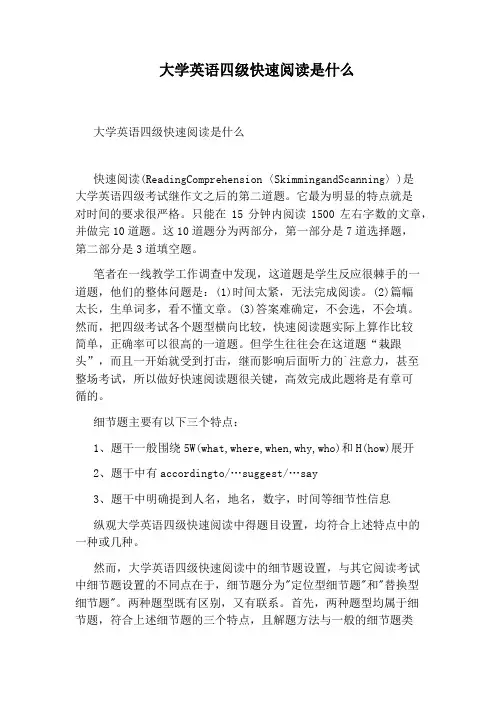
大学英语四级快速阅读是什么大学英语四级快速阅读是什么快速阅读(ReadingComprehension〈SkimmingandScanning〉)是大学英语四级考试继作文之后的第二道题。
它最为明显的特点就是对时间的要求很严格。
只能在15分钟内阅读1500左右字数的文章,并做完10道题。
这10道题分为两部分,第一部分是7道选择题,第二部分是3道填空题。
笔者在一线教学工作调查中发现,这道题是学生反应很棘手的一道题,他们的整体问题是:(1)时间太紧,无法完成阅读。
(2)篇幅太长,生单词多,看不懂文章。
(3)答案难确定,不会选,不会填。
然而,把四级考试各个题型横向比较,快速阅读题实际上算作比较简单,正确率可以很高的一道题。
但学生往往会在这道题“栽跟头”,而且一开始就受到打击,继而影响后面听力的`注意力,甚至整场考试,所以做好快速阅读题很关键,高效完成此题将是有章可循的。
细节题主要有以下三个特点:1、题干一般围绕5W(what,where,when,why,who)和H(how)展开2、题干中有accordingto/…suggest/…say3、题干中明确提到人名,地名,数字,时间等细节性信息纵观大学英语四级快速阅读中得题目设置,均符合上述特点中的一种或几种。
然而,大学英语四级快速阅读中的细节题设置,与其它阅读考试中细节题设置的不同点在于,细节题分为"定位型细节题"和"替换型细节题"。
两种题型既有区别,又有联系。
首先,两种题型均属于细节题,符合上述细节题的三个特点,且解题方法与一般的细节题类似。
而两者的区别在于,"定位型细节题"只考察考生定位特定信息的能力。
顾名思义,只要找到了原题的位置,即能选对选项。
客观地说,这种题型无法检验出考生英语的真实能力。
因此,"替换型细节题"应运而生。
"替换型细节题"不但考查考生定位原文信息的能力,更考查考生对语言的掌握。
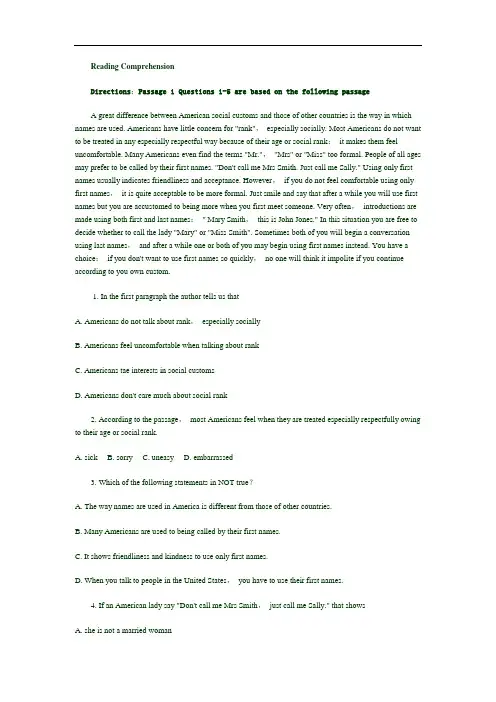
Reading ComprehensionDirections:Passage 1 Questions 1-5 are based on the following passageA great difference between American social customs and those of other countries is the way in which names are used. Americans have little concern for "rank",especially socially. Most Americans do not want to be treated in any especially respectful way because of their age or social rank;it makes them feel uncomfortable. Many Americans even find the terms "Mr.","Mrs" or "Miss" too formal. People of all ages may prefer to be called by their first names. "Don't call me Mrs Smith. Just call me Sally." Using only first names usually indicates friendliness and acceptance. However,if you do not feel comfortable using only first names,it is quite acceptable to be more formal. Just smile and say that after a while you will use first names but you are accustomed to being more when you first meet someone. Very often,introductions are made using both first and last names:" Mary Smith,this is John Jones." In this situation you are free to decide whether to call the lady "Mary" or "Miss Smith". Sometimes both of you will begin a conversation using last names,and after a while one or both of you may begin using first names instead. You have a choice:if you don't want to use first names so quickly,no one will think it impolite if you continue according to you own custom.1. In the first paragraph the author tells us thatA. Americans do not talk about rank,especially sociallyB. Americans feel uncomfortable when talking about rankC. Americans tae interests in social customsD. Americans don't care much about social rank2. According to the passage,most Americans feel when they are treated especially respectfully owing to their age or social rank.A. sickB. sorryC. uneasyD. embarrassed3. Which of the following statements in NOT true?A. The way names are used in America is different from those of other countries.B. Many Americans are used to being called by their first names.C. It shows friendliness and kindness to use only first names.D. When you talk to people in the United States,you have to use their first names.4. If an American lady say "Don't call me Mrs Smith,just call me Sally." that showsA. she is not a married womanB. she prefers to be called "Sally"C. she is not Mrs SmithD. she likes to be more formal5. The passage you've just read would most likely be found in aA. guide-book for touristsB. book about American historyC. noticeD. short storyPASSAGE 1美国与其他国家社会习俗的一个显著不同是名字的使用方式。
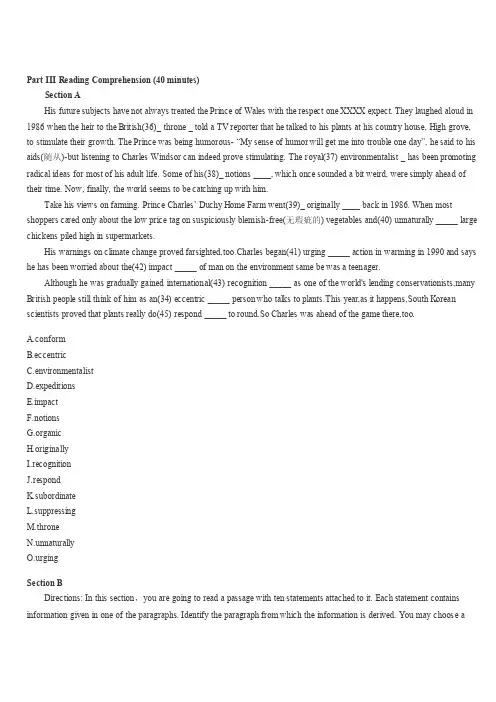
Part III Reading Comprehension (40 minutes)Section AHis future subjects have not always treated the Prince of Wales with the respect one XXXX expect. They laughed aloud in 1986 when the heir to the British(36)_ throne _ told a TV reporter that he talked to his plants at his country house, High grove, to stimulate their growth. The Prince was being humorous- “My sense of humor will get me into trouble one day”, he said to his aids(随从)-but listening to Charles Windsor can indeed prove stimulating. The royal(37) environmentalist _ has been promoting radical ideas for most of his adult life. Some of his(38)_ notions ____, which once sounded a bit weird, were simply ahead of their time. Now, finally, the world seems to be catching up with him.Take his vi ews on farming. Prince Charles’ Duchy Home Farm went(39)_ originally ____ back in 1986. When most shoppers cared only about the low price tag on suspiciously blemish-free(无瑕疵的) vegetables and(40) unnaturally _____ large chickens piled high in supermarkets.His warnings on climate change proved farsighted,too.Charles began(41) urging _____ action in warming in 1990 and says he has been worried about the(42) impact _____ of man on the environment same be was a teenager.Although he was gradually gained international(43) recognition _____ as one of the world's lending conservationists,many British people still think of him as an(34) eccentric _____ person who talks to plants.This year,as it happens,South Korean scientists proved that plants really do(45) respond _____ to round.So Charles was ahead of the game there,too.A.conformB.eccentricC.environmentalistD.expeditionsE.impactF.notionsanicH.originallyI.recognitionJ.respondK.subordinateL.suppressingM.throneN.unnaturallyO.urgingSection BDirections: In this section,you are going to read a passage with ten statements attached to it. Each statement contains information given in one of the paragraphs. Identify the paragraph from which the information is derived. You may choos e aparagraph more than once. Each paragraph is marked with a letter. Answer the questions by marking the corresponding letter on Answer Sheet 2.High School Sports Aren’t Killing AcademicsA)In this month’s Atlantic cover article, “The Case Against High-School Sports,” Amanda Ripley argues thatschool-sponsored sports programs should be seriously cut. She writes that, unlike most countries that outperform the United States on international assessments, American schools put too much of an emphasis on athl etics, “ Sports are embedded in American schools in a way they are not almost anywhere else,” she writes, “Yet this difference hardly ever comes up in domestic debates about America’s international mediocrity(平庸)in education.”B)American student-athletes reap many benefits from participating in sports, but the costs to the schools could outweigh their benefits, she argues, In particular, Ripley contends that sports crowd out the academic missions of schools: America should learn from South Korea and Finland and every other country at the top level of international test scores, all of whom emphasize athletics far less in school. ”Even in eighth grade, American kids spend more than twice the time Korean kids spend playing sports,” she writes, citing a 2010 s tudy published in the Journal of Advanced Academics.C)It might well be true that sports are far more rooted in American high schools than in other countries. But our reading of international test scores finds no support for the argument against school athletics. Indeed, our own research and that of others lead us to make the opposite case. School-sponsored sports appear to provide benefits that seem to increase, not detract(减少)from, academic success.D)Ripley indulges a popular obsession(痴迷)with international test score comparisons, which show wide and frightening gaps between the United States and other countries. She ignores, however, the fact that states vary at least as much in test scores as do developed countries. A 2011 report from Harvard University shows that Massachusetts produces math scores comparable to South Korea and Finland, while Mississippi scores are closer to Trinidad and Tobago. Ripley’s thesis about sports falls ap art in light of this fact. Schools in Massachusetts provide sports programs while schools in Finland do not. Schools in Mississippi may love football while in Tobago interscholastic sports are nowhere near as prominent. Sports cannot explain these similarities in performance. They can’t explain international differences eit her.E)If it is true that sports undermine the academic mission of American schools, we would expect to see a negative relationship between the commitment to athletics and academic achievement. However, the University of Arkansas’s Daniel Bowen and Jay G reene actually find the opposite. They examine this relationship by analyzing schools’ sports winning percentages as well as student-athletic participation rates compared to graduation rates and standardized test score achievement over a five-year period for all public high schools in Ohio. Controlling for student poverty levels, demographics(人口统计状况), and district financial resources, both measures of a school’s commitment to athletics are significantly and positively relate d to lower dropout rates as well as higher test scores.F)On-the-field success and high participation in sports is not random-it requires focus and dedication to athletics. One might think this would lead schools obsessed with winning to deemphasize academics. Bowen and Greene’s results contradictthat argument. A likely explanation for this seemingly counterintuitive(与直觉相反的)result is that success in sports programs actually facilitates or reflects greater social capital within a school’s community.G)Ripley cites the writings of renowned sociologist James Coleman, whose research in education was groundbreaking. Coleman in his early work held athletics in contempt, arguing that they crowded out schools’ academic missions. Ripley quotes his 1961 study, The Adolescent Society, where Colem an writes, “Altogether, the trophy(奖品)case would suggest to the innocent visitor that he was entering an athletic club, not an educational institution.”H)However, in later research Coleman would show how the success of schools is highly dependent on what he termed social capital, “the social networks, and the relationships between adults and children that are of value for the child’s gro wing up.”I)According to a 2013 evaluation conducted by the Crime Lab at the University of Chicago, a program called Becoming a Man-Sports Edition creates lasting improvements in the boys’ study habits and grade point averages. During the first year of the program, students were founds to be less likely to transfer schools or be engaged in violent crime. A year after the program, participants were less likely to have had an encounter with the juvenile justice system.J)If school-sponsored sports were completely eliminated tomorrow, many American students would still have opportunities to participate in organized athletics elsewhere, much like they do in countries such as Finland, Germany, and South Korea. The same is not certain when it comes to students from more disadvantaged backgrounds. In an overview of the research onnon-school based after-school programs, researchers find that disadvantaged children participate in these programs at significantly lower rates. They find that low-income students have less access due to challenges with regard to transportation, non-nominal fees, and off-campus safety. Therefore, reducing or eliminating these opportunities would most likely deprive disadvantaged students of the benefits from athletic participation, not least of which is the opportunity to interact with positive role models outside of regular school hours.K)Another unfounded criticism that Ripley makes is bringing up the stereotype that athletic XX are typically lousy(蹩脚的)classroom teachers. “American principals, unlike the XX XX of principals around the world, make many hiring decisions with their sports teams in mind, which does not always end well for students,” she writes. Educators who seek employment at schools primarily for the purpose of coaching are likely to shirk(推卸)teaching responsibilities, the argument goes. Moreover, even in the cases where the employee is a teacher first and athletic coach second, the additional responsibilities that come with coaching likely comes at the expense of time otherwise spent on planning, grading, and communicating with parents and guardians.L)The data, however, do not seem to confirm this stereotype. In the most rigorous study on the classroom results of high school coaches, the University of Arkansas’s Anna Egalite finds that athletic coaches in Florida mostly tend to perform just as well as their non-coaching counterparts, with respect to raising student test scores. We do not doubt that teachers who also coach face serious tradeoffs that likely come at the expense of time they could dedicate to their academic obligations. However, aswith sporting events, athletic coaches gain additional opportunities for communicating and serving as mentors(导师)that potentially help students succeed and make up for the costs of coaching commitments.M)If schools allow student-athletes to regularly miss out on instructional time for the sake of traveling to athletic competitions, that’s bad. However, such issues would be better addressed by changing school and state policies with regard to the scheduling of sporting events as opposed to total elimination. If the empirical evidence points to anything, it points towards school sponsored sports providing assets that are well worth the costs.N)Despite negative stereotypes about sports culture and Ripley’s presumption that academics and athletics are at odds with one another, we believe that the greater body of evidence shows that school-sponsored sports programs appear to benefit students. Successes on the playing field can carry over to the classroom and vice versa(反之亦然). More importantly, finding ways to increase school communities’ social c apital is imperative to the success of the school as whole, not just the athletes.46.Stunets from low-income families have less access to off-campus sports programs.47.Amanda Ripley argues that America should learn from other countries that rank high in international tests and lay less emphasis on athletics.48.According to the author,Amanda Ripley fails to note that students' performance in exams varies from state to state.49.Amanda Ripley thinks that athletic coaches are poor at classroom instruction.50.James Coleman's later research make an argument for a school's social capital.51.Researchers find that there is a positive relationship between a school's commitment to athletics and academic achievements.52.A rigorous study finds that athletic coaches also do well in raising students' test scores.53.According to an evaluation,programs contribute to students' academic performance and character building.54.Amanda Ripley believes the emphasis on school sports should be brought up when trying to understand why American students are mediocre.55.James Coleman suggests in his earlier writings that school athletics would undermine a school's imageSection CDirections: There are 2 passages in this section. Each passage is followed by some questions or unfinished statements. For each of them there are four choices marked A, B, C and D. . You should decide on the best choice and mark the corresponding letter on Answer Sheet 2 with a single line through the centre.Passage oneIt is easy to miss amid the day-to-day headlines of global economic recession, but there is a less conspicuous kind of social upheaval(剧变)underway that is fast altering both the face of the planet and the way human beings live. That change is the rapid acceleration of urbanization. In 2008, for the first time in human history, more than half the world’s population was living in towns and cities. And as a recently published paper shows, the process of urbanization will only accelerate in the decades to come—with an enormous impact on biodiversity and potentially on climate change.As Karen Seto, the led author of the paper, points out, the wave of urbanization isn’t just about the migration of people int o urban environments, but about the environments themselves becoming bigger to accommodate all those people. The rapidexpansion of urban areas will have a huge impact on biodiversity hotspots and on carbon emissions in those urban areas.Humans are the ultimate invasive species—when the move into new territory, the often displace the wildlife that was already living there. And as land is cleared for those new cities—especially in the dense tropical forests—carbon will be released into the atmosphere as well. It’s true that as people in developing nations move from the countryside to the city, the shift may reduce the pressure on land, which could in turn be good for the environment. This is especially so in desperately poor countries, where residents in the countryside slash and burn forests each growing season to clear space for farming. But the real difference is that in developing nations, the move from rural areas to cities often leads to an accompanying increase in income — and that increase leads to an increase in the consumption of food and energy, which in turn causes a rise in carbon emissions. Getting enough to eat and enjoying the safety and comfort of living fully on the grid is certainly a good thing — but it does carry an environmental price.The urbanization wave can’t be stopped —and it shouldn’t be. But Seto’s p aper does underscore the importance of managing that transition. If we do it the right way, we can reduce urbanization’s impact on the environment. “There’s an enormous opportunity here, and a lot of pressure and responsibility to think about how we urbani ze,” says Seto. “One thing that’s clear is that we can’t build cities the way we have over the last couple of hundred years. The scale of this transition won’t allow that.” We’re headed towards an urban planet no matter what, but whether it becomes heaven or hell is up to us.56. What issue does the author try to draw people’s attention to?A. The shrinking biodiversity worldwide.B. The rapid increase of world population.C. The ongoing global economic recession.D. The impact of accelerating urbanization.57. In what sense are humans the ultimate invasive species?A. They are much greedier than other species.B. They are a unique species born to conquer.C. They force other species out of their territories.D. They have an urge to expand their livingspace.58. In what way is urbanization in poor countries good for the environment?A. More land will be preserved for wildlife.B. The pressure on farmland will be lessened.C. Carbon emissions will be considerably reduced.D. Natural resources will be used moreeffectively.59. What does the author say about living comfortably in the city?A. It incurs a high environmental price.B. It brings poverty and insecurity to an end.C. It causes a big change in people’s lifestyle.D. It narrows the gap betwee n city and country.60. What can be done to minimize the negative impact of urbanization according to Seto?A. Slowing down the speed of transition.B. Innovative use of advanced technology.C. Appropriate management of the process.D. Enhancing people’s sense of responsibility.Passage TwoWhen Harvard student Mark Zuckerberg launched the in Feb. 2004, even he could not imagine the forces it would let loose. His intent was to connect college students. Facebook, which is what this website rapidly evolved into, ended up connecting the world.To the children of this connected era, the world is one giant social network. They are not bound — as were previous generations of humans — by what they were taught. They are only limited by their curiosity and ambition. During my childhood,all knowledge was local. You learned everything you knew from your parents, teachers, preachers, and friends.With the high-quality and timely information at their fingertips, today’s children are rising norm ally tame middle class is speaking up against social ills. Silicon Valley executives are being shamed into adding women to their boards. Political leaders are marshalling the energy of millions for elections and political causes. All of this is being done with social media technologies that Facebook and its competitors set free.As does every advancing technology, social media has created many new problems. It is commonly addictive and creates risks for younger users. Social media is used by extremists in the Middle East and elsewhere to seek and brainwash recruits. And it exposes us and our friends to disagreeable spying. We may leave our lights on in the house when we are on vacation, but through social media we tell criminals exactly where we are, when we plan to return home, and how to blackmail(敲诈)us.Governments don’t need informers any more. Social media allows government agencies to spy on their own citizens. We record our thoughts, emotions, likes and dislikes on Facebook; we share our political views, social preferences, and plans. We post intimate photographs of ourselves. No spy agency or criminal organization could actively gather the type of data that we voluntarily post for them.The marketers are also seeing big opportunities. Amazon is trying to predict what we will order. Google is trying to judge our needs and wants based on our social-media profiles. We need to be aware of the risks and keep working to alleviate the dangers.Regardless of what social media people use, one thing is certain: we are in a period of accelerating change. The next decade will be even more amazing and unpredictable than the last. Just as no one could predict what would happen with social media in the last decade, no one can accurately predict where this technology will take us. I am optimistic, however, that a connected humanity will find a way to uplift itself.61. What was the purpose of Facebook when it was first created?A. To help students connect with the outside world.B. To bring university students into closercontact.C. To help students learn to live in a connected era.D. To combine the world into an integralwhole.62. What difference does social media make to learning?A. Local knowledge and global knowledge will merge.B. Student will become more curious andambitious.C. People are able to learn wherever they travel.D. Sources of information are greatly expanded.63. What is the author’s greatest concern with social media technology?A. Individuals and organizations may use it for evil purposes.B. Government will find it hard toprotect classified information.C. People may disclose their friends’ information unintentionally.D. People’s attention will beeasily distracted from their work in hand.64. What do businesses use social media for?A. Creating a good corporate image.B. Conducting large-scale market surveys.C. Antic ipating the needs of customers.D. Minimizing possible risks and dangers.65. What does the author think of social media as a whole?A. It will enable human society to advance at a faster pace.B. It will pose a grave threat to ourtraditional ways of life.C. It is bound to bring about another information revolution.D. It breaks down the final barriers inhuman communication.Part IV TranslationDirections: For this part, you are allowed 30 minutes to translate a passage from Chinese into English. You should write your answer on Answer Sheet 2.翻译题一:自从1978年启动改革以来,中国已从计划经济转为以市场为基础的经济,经历了经济和社会的快速发展。
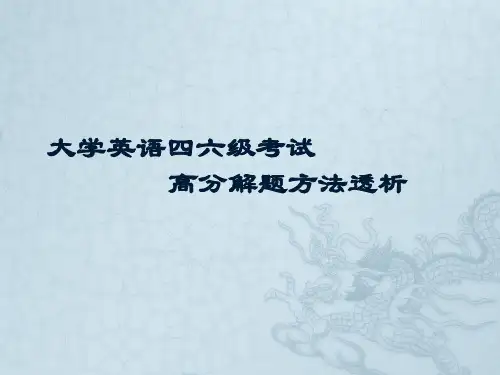
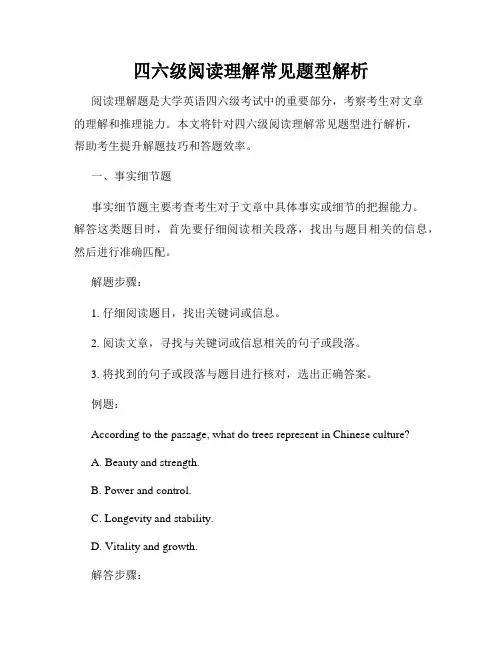
四六级阅读理解常见题型解析阅读理解题是大学英语四六级考试中的重要部分,考察考生对文章的理解和推理能力。
本文将针对四六级阅读理解常见题型进行解析,帮助考生提升解题技巧和答题效率。
一、事实细节题事实细节题主要考查考生对于文章中具体事实或细节的把握能力。
解答这类题目时,首先要仔细阅读相关段落,找出与题目相关的信息,然后进行准确匹配。
解题步骤:1. 仔细阅读题目,找出关键词或信息。
2. 阅读文章,寻找与关键词或信息相关的句子或段落。
3. 将找到的句子或段落与题目进行核对,选出正确答案。
例题:According to the passage, what do trees represent in Chinese culture?A. Beauty and strength.B. Power and control.C. Longevity and stability.D. Vitality and growth.解答步骤:1. 关键词:trees, represent, Chinese culture。
2. 阅读文章,寻找与关键词相关的句子或段落。
3. 找到相关句子:"In Chinese culture, trees symbolize longevity, stability, and growth."4. 核对答案,选出正确选项:C. Longevity and stability.二、推理判断题推理判断题主要考查考生根据文章中的线索进行推理和判断的能力。
解答这类题目时,需要准确把握关键信息,并根据上下文进行逻辑推理。
解题步骤:1. 仔细阅读题目,找出问题所在。
2. 阅读相关段落,寻找线索。
3. 根据线索进行推理和判断。
4. 核对答案,选出正确选项。
例题:What can be inferred from the passage?A. Pollution is the main cause of climate change.B. Climate change affects only wildlife.C. The Earth's temperature has been rising for decades.D. The government is taking effective measures to combat climate change.解答步骤:1. 关键词:inferred, passage。
解析四六级考试阅读理解题型及解题技巧考试是对学生综合能力的一种考核方式,而四六级考试作为我国大学英语教学的重要组成部分,阅读理解题型占据了相当大的比例。
对于考生来说,了解不同的题型及解题技巧是提高阅读理解得分的关键。
本文将对四六级考试中常见的阅读理解题型进行分析,并提供一些解题技巧供大家参考。
一、题型分析1. 主旨大意题主旨大意题要求考生从整体上把握文章的主要内容和意图,通常以提问文章的标题为主。
解答这类题目时,考生需要综合考虑文章的主题、段落的主题句以及关键词等信息,快速准确地选出正确答案。
解题技巧:仔细阅读文章首尾句,找出文章的中心思想。
同时,注意文章中的关键词,它们往往能够帮助我们确定文章的主要内容。
2. 主题段落题主题段落题是要求考生从给定的几个段落中选择一个段落与其他段落的主题最相符。
解决这类题目时,考生需要对各个段落进行整体把握,找出它们的中心思想,进而选出最符合要求的段落。
解题技巧:阅读每个段落的主题句,通过主题句来理解段落的大意,进而判断与其他段落的关系。
关注技巧性的词语如转折词、因果关系词等,有助于理解段落的逻辑结构。
3. 细节题细节题要求考生根据文章的具体细节选择正确的答案。
这类题目在考试中常出现且数量较多,解答时需要阅读全文并仔细筛选信息。
解题技巧:注意文章中数字、时间、地点等具体细节信息。
关注一些排除性的词语如"not"、"except"等,有助于缩小选项范围。
4. 推理判断题推理判断题要求考生在阅读理解的基础上进行推理判断。
通常通过文章中的隐含信息和逻辑推断来选择正确答案。
解题技巧:仔细理解文章中的信息,把握作者的观点和逻辑关系。
注意逻辑词如"because"、“therefore"、“so"等,它们能够帮助我们推断答案。
二、解题技巧1. 抓住关键词阅读理解的过程中,抓住关键词是解题的关键。
英语四级的考试题型英语四级的考试题型篇一:英语四级的考试题型tion A: 阅读理解(Reading Comprehension)本节共有数篇短文。
短文共长1500个词左右。
每篇短文后有若干道多项选择题。
考生应根据文章内容从每题四个选择项中选出一个最佳答案。
共15题。
Section B:快速阅读(Skimming and Scanning)本节共有数篇短文。
短文共长900词左右。
每篇短文后有若干道多项选择题。
考生应根据文章内容从每题四个选择项中选出一个最佳答案。
共10题。
考试时间共5分钟。
(三)测试目的阅读理解部分是测试学生通过阅读获取信息的能力。
既要求准确,也要求一定的速度。
快速阅读部分是测试学生通过快速阅读获取信息的能力。
既要求快速,也要求正确。
(四)选材原则1、题材广泛,包括社会、文化、日常知识、科普常识、人物传记等。
但是,所涉及的背景知识应能为学生所理解。
2、体裁多样,包括记叙文、说明文、议论文等。
3、文章的语言难度中等,所用词汇基本上不超出教学大纲词汇表对四级所规定的范围。
4、快速阅读部分的材料与阅读理解部分的.材料相仿,但相对容易些。
体裁上除上述之外还可包括广告、说明书等。
答题和计分:本考试分为试卷一和试卷二。
试卷一(Part I和Part II)为主观试题,要求考生用钢笔或圆珠笔把作文和听写直接写在答题卷上。
主观试题按统一规定的评分标准评分。
试卷二(Part III, part IV, Part V和Part VI)为多项选择题,要求考生从每题所给的A,B,C,D四个选择项中选出一个最佳答案,并根据要求用2B铅笔在答题纸上划线。
做在试卷上的答案无效。
每题只能选择一个答案,多选作废。
多项选择题只算答对的题数,答题不扣分。
多项选择题由机器阅卷。
试卷各部分采用记权的办法,折算成百分制。
以60分为及格标准。
篇二:英语四级考试题型分析一、四六级总分值占比&考试时间四六级总分为710分,分值比例为:作文15%,听力35%,阅读35%,翻译15%,即作文106.5分,听力248.5分,阅读248.5分,翻译106.5分。
四六级阅读题型分析阅读理解是英语四六级考试中的重要部分,考察学生对英语文章的理解和分析能力。
在阅读模块中,通常有多种不同类型的题目,如细节理解题、词义推测题、主旨大意题等。
本文将对四六级阅读中常见的题型进行分析和解答技巧介绍。
一、细节理解题细节理解题是四六级阅读中最常见的题型之一。
这类题目要求考生在文章中找出特定的细节信息。
在解答这类题目时,考生需要注意以下几点:1. 通读全文:在做题前,考生应先通读全文,把握文章主题和结构。
这有助于把握文章脉络,提高解题效率。
2. 关注问题关键词:在阅读问题时,要特别关注问题中的关键词,如特定数词、人名、地名等。
这有助于快速定位相关答案。
3. 利用排除法:如果答案不立即显现,可以使用排除法。
排除明显错误的选项,缩小范围,再进行推断和分析。
二、词义推测题词义推测题是四六级阅读中另一个常见的题型。
这类题目要求考生根据上下文推测给定词语的意思。
解答这类题目时,考生可以尝试以下方法:1. 学会运用词根词缀:对于生词,考生可以根据其词根和词缀来推测词义。
比如,"bio-"表示生命,"-logy"表示学科,可以推测"biology"的意思是"生物学"。
2. 利用上下文线索:上下文提供了很多线索,可以帮助考生推测词义。
考生可以关注上文和下文中的词语、词性、句子结构等,从中推测词义。
3. 加强词汇积累:通过积累大量的词汇,加强对词义的掌握,提高词义推测的准确性。
三、主旨大意题主旨大意题是阅读理解中最基础的题型之一。
这类题目要求考生根据全文内容回答问题,包括文章的中心思想、主题等。
处理这类题目时,考生需要注意以下几点:1. 全面理解文章:要准确把握文章的整体内容和思路,了解文章作者想传达的信息。
2. 找出关键句:关键句是文章的核心句或能够准确概括文章主题的句子。
通过找出关键句,可以更好地回答主旨大意题。
分析四六级中的阅读题型近年来,英语四六级考试中对阅读题型的要求越来越高,考生需要在有限的时间内准确理解文章内容,并作出正确的判断、推理、总结等题目要求的答案。
本文将分析四六级中的阅读题型,解析其特点和应对方法,以帮助考生提升阅读能力。
一、主旨题主旨题是四六级阅读中最基础也是最常见的题型,要求考生理解全文大意,确定作者的中心观点或主要目的。
通常,主旨题出现在文章的开头或结尾,或者围绕文章的关键段落展开。
解题技巧:1.注意文章的标题、首尾段和总结句,它们通常能给出文章的主旨;2.理解段落之间的逻辑关系,找出作者表达的中心思想;3.排除干扰选项,选择与文章内容最相关的答案。
二、细节题细节题要求考生在文章中找到具体事实、细节或数据,通常需要注意句子中的关键词、数字和名词解释等,以确保答案的准确与完整。
解题技巧:1.注意文章的时间、地点和人物等关键信息;2.使用扫读、略读等阅读技巧,快速找出问题相关的句子或段落;3.对答案进行逐个排除和对比,选择最符合原文的选项。
三、词义理解题词义理解题要求考生理解文章中的生词或重点词汇,确定其在文章中的含义,以此来推断句子或段落的意思。
解题技巧:1.通过上下文来推测生词的意思;2.注意生词的词根、前缀和后缀等,结合词形变化进行推断;3.灵活借助词典或其他阅读材料来增加对生词的理解。
四、推理判断题推理判断题要求考生依据文章的信息,进行推理、判断或合理推断,以回答问题或完成相应的任务。
解题技巧:1.注意文章中的因果关系、顺序连接词等线索,推断出答案;2.准确理解作者的意图或观点,以此为基础进行推理;3.避免过度推理或带入个人观点,以原文内容为准。
五、态度观点题态度观点题要求考生判断作者在文章中的态度或观点,并选择最符合原文的答案。
解题技巧:1.注意作者所使用的情感词汇、修辞手法等,判断其态度;2.理解段落的脉络,考虑作者在整篇文章中的观点;3.避免根据个人喜好或主观臆断作答,以原文为准。
四六级中的短篇阅读题型分析近年来,英语四六级考试的阅读部分一直是备受考生关注的重点。
其中,短篇阅读题更是考生们备战的难点之一。
本文将对四六级考试中的短篇阅读题型进行分析和解读,帮助考生们更好地应对这一考点。
在四六级考试的阅读部分中,短篇阅读题型通常分为多项选择题和填空题两种。
多项选择题要求考生根据短文内容,选择最佳的答案;填空题则需要考生根据短文,填写相应的信息。
下面,我们将分别对这两种题型进行具体的分析。
首先是多项选择题。
这种题型要求考生在阅读短文后,理解文章的大意和细节,并在选项中选择与短文相符的最佳答案。
在解答这种题型时,考生可以采取逐题阅读法。
逐题阅读法指考生在解答问题时,可以先看题目,再根据题目信息有针对性地阅读短文,找出与题目相关的信息。
同时,考生应该注意选项之间的区别,排除无关选项,选择最符合短文的答案。
此外,在解答过程中注意字面含义和上下文的联系也是非常重要的。
其次是填空题。
填空题要求考生在短文的空白处填写适当的单词或短语,补充文章所缺少的信息。
在解答这种题型时,考生需注意短文的逻辑关系和上下文的引导,以及选择合适的选项。
与多项选择题不同的是,填空题的选项并不像选择题那样给出,考生需要自己根据短文的内容来填写答案。
因此,在解答填空题时,考生应通过综合理解短文的意思和上下文的信息,找寻合适的答案。
有时候,填空题答案可能会与短文中的关键词相关,考生可以通过对关键词及其上下文信息进行分析,在填写答案时更加准确。
除了解答题目外,考生还应该注意提高答题效率。
在解答短篇阅读题时,一些高效的阅读技巧可以帮助考生更好地掌握短文的内容。
例如,扫读短文,了解文章整体结构和段落大意,可以帮助考生更好地把握文章的主题和脉络,提前掌握文章的基本信息。
此外,注意抓住文章的关键句和重点词汇,可以帮助考生在解答问题时更加准确和迅速。
另外,划线标记法是一种常用的阅读技巧,考生可以在阅读短文时,标记出与试题相关的信息和关键词,以便在解答题目时更加轻松地找到答案。